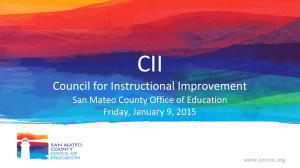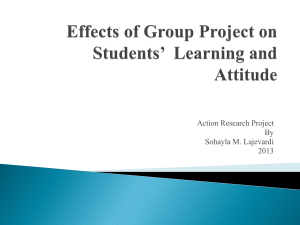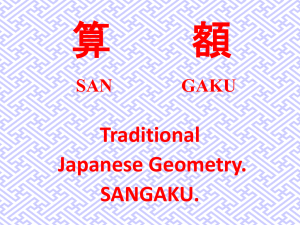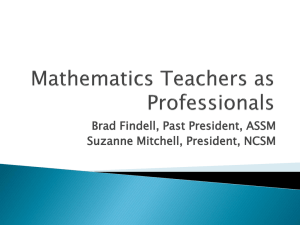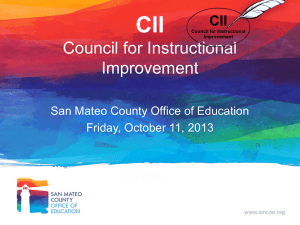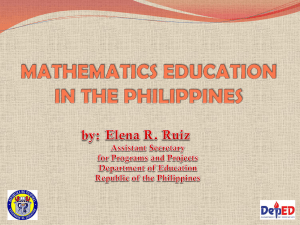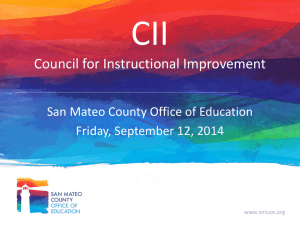Mathematics Framework Content
advertisement
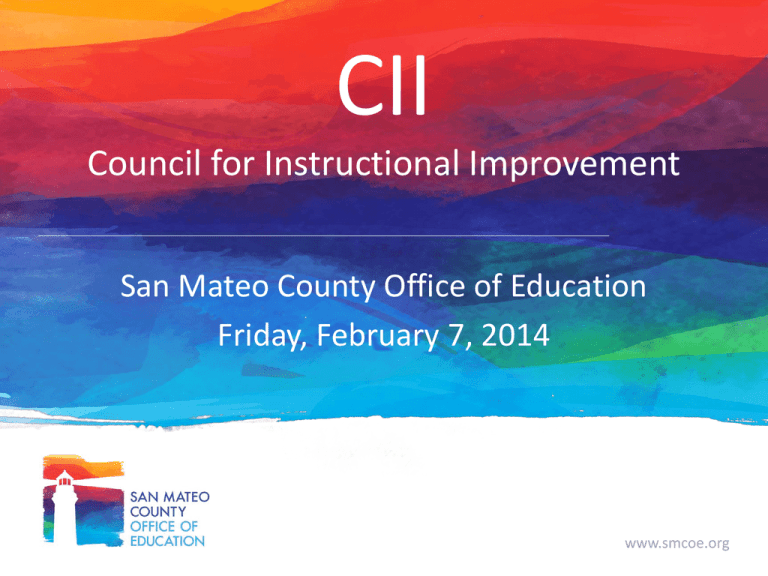
CII Council for Instructional Improvement San Mateo County Office of Education Friday, February 7, 2014 www.smcoe.org Agenda Welcome, Review Agenda State/Federal Updates California Mathematics Framework Math Curriculum Evaluation Toolkit Break Common Core State Standards for Mathematics and the Smarter Balanced Assessments www.smcoe.org www.smcoe.org State and Federal Updates www.smcoe.org Mathematics Framework 5 www.smcoe.org Goals for the Mathematics Framework • Guide the field in implementing the CA CCSSM • Emphasize coherence across and within grade levels • Integrate the Standards for Mathematical Practice and Standards for Mathematical Content • Provide guidance on the higher mathematics course progression 6 www.smcoe.org Development of the Mathematics Framework • Focus Group members—all educators in California K–12 public schools, four regional meetings • Mathematics Framework Committee members—a majority of teachers, including teachers with experience teaching English learners and students with disabilities, other educators, and two content experts with Ph.Ds. in mathematics • IQC—teachers, curriculum leaders, and administrators • Staff of the Curriculum Frameworks and Instructional Resources Division and mathematics expert Dr. Christopher Yakes 7 www.smcoe.org Development of the Mathematics Framework • The field—provided comments on the draft Framework during two 60-day review periods • County Offices of Education—held discussion forums on the first draft of the Mathematics Framework • Common Core State Standards for Mathematics author and expert Jason Zimba • WestEd’s California Comprehensive Center, Neal Finkelstein and Dona Meinders • Staff of the California Department of Education’s Language Policy and Leadership Office, STEM Office, and Assessment Transition Office 8 www.smcoe.org What is in the Mathematics Framework? • • • • Introduction Overview of Standards Chapters Grade-level chapters, TK8 Higher mathematics chapters by course: – – – – – – – Traditional pathway (Algebra I, Geometry, Algebra II) Integrated pathway (Mathematics I, II, and III) Pre-calculus Statistics and Probability Advanced Placement Probability and Statistics Calculus Mathematical Modeling 9 www.smcoe.org What is in the Mathematics Framework? • Universal Access • Instructional Strategies • Supporting High-Quality Common Core Mathematics Instruction • Technology in the Teaching of Mathematics • Assessment • Instructional Materials to Support the CA CCSSM (including the evaluation criteria for the mathematics adoption) 10 www.smcoe.org What is in the Appendix? A. Financial Literacy and Mathematics Education B. Mathematical Modeling C. Method Used for Solving Single-digit Addition and Subtraction Problems D. Course Placement and Sequences E. Possible Adaptations for Students with Learning Difficulties in Mathematics F. Higher Mathematics Pathways Standards Chart 11 www.smcoe.org K-8 Mathematics Framework Content Focus Coherence Rigor • A focus on understanding addition, subtraction, multiplication, and division (the four operations) in K5 • Building from whole numbers in K2 to fractions in grades 35 • Expectations of fluency with whole numbers and fractions in K5 12 www.smcoe.org K-8 Mathematics Framework Content Focus Coherence Rigor • A focus on ratio, rates, percent, and statistics and probability in 68 • Extending operations with fractions to rational numbers in 68 • Expectations of fluency with expressions and linear equations 68 13 www.smcoe.org Structure of the Grade-Level Chapters • Short discussion of learning in previous grade • Four critical areas of instruction • Standard or cluster of standards with a narrative that provides additional explanation • Sample problems that further illustrate the standard • Grade level explanations and examples for the Standards for Mathematical Practice 14 www.smcoe.org Higher Mathematics Mathematics Framework Content • • • • • • • Traditional Pathway (Algebra I, Geometry, Algebra II) Integrated Pathway (Mathematics I, II, and III) Precalculus Statistics and Probability Calculus AP Probability and Statistics Mathematical Modeling 15 www.smcoe.org Higher Mathematics Mathematics Framework Content Focus Coherence Rigor • A focus on the mathematics that students need for success in college and careers • Extending from algebraic concepts to calculus, trigonometry, and advanced statistics • Expectation that students are college and career ready and able to utilize mathematics in their lives 16 www.smcoe.org Universal Access • California’s student diversity • Planning and support for a range of leaners using Universal Design for Learning (UDL) and Multi-Tiered Systems of Supports (MTSS) • Strategies to meet the increased language demands of the California Common Core State Standards for Mathematics 17 www.smcoe.org Instructional Strategies • Key Instructional Shifts in the CA CCSSM • Instructional Models • Instructional Strategies for the Mathematics Classroom • Tools for Mathematics Instruction 18 www.smcoe.org Technology in the Teaching of Mathematics • Technology as a integral tool in the mathematics classroom • Illustrative examples by grade level • Educational Technology (e.g. interactive clickers, smart phones, tablets) • Assistive Technology 19 www.smcoe.org Assessment • Purposes and types of assessments – Formative assessment for learning – Summative assessment of learning • Methods and tools for assessment • Sample rubrics • Grading, homework, and the Smarter Balanced Assessments 20 www.smcoe.org Instructional Materials to Support CCSS • Contains the “Criteria for Evaluating Mathematics Instructional Materials for Kindergarten through Grade Eight,” which was the basis for the January 2014 adoption • Provides guidance to districts on adopting instructional materials for higher mathematics, including indicators of quality • Outlines a process for local adoptions 21 www.smcoe.org Supporting High-Quality Common Core Mathematics Instruction • Administrator Roles and Support • Professional learning, including sources, research, and critical content • Leadership and professional collaboration • Other programs of support (e.g., extended learning, parents and families) 22 www.smcoe.org Supporting High-Quality Common Core Mathematics Instruction Recommendations: • Teacher Education • Mentoring for Beginners • Professional Learning Time • Evaluation • Leadership Pathways From the “Greatness by Design Report: Supporting Outstanding Teaching to Sustain a Golden State. A report by State Superintendent of Public Instruction Tom Torlakson’s Task Force on Educator Excellence September 2012 www.smcoe.org Professional Learning for Teachers Content • Deepen mathematics teachers’ content knowledge and provide effective instruction strategies. • Engage in solving problems through using the mathematical practices. Pedagogy • problem solving strategies • Multiple representation • Formative assessment strategies 24 www.smcoe.org Forms of Professional Learning • Sustained, content-embedded, collegial and connected to practice • Focused on student learning • Models – Summer – Teacher collaboration – Lesson Study – Fostering teacher leaders www.smcoe.org Evaluation of Instruction • Tie evaluation to useful feedback and to profession learning opportunities • Assess alignment to CCSS • Include both formative and summative assessments • Differentiate support • Build on successful peer assistance • Value and promote collaboration www.smcoe.org What? How? When? Who? Take a few minutes to reflect on the recommendations from the Greatness by Design report by filling in the Supporting High-Quality Common Core Mathematics Instruction template. www.smcoe.org View the Framework at http://www.cde.ca.gov/ci/ma/cf/d raft2mathfwchapters.asp www.smcoe.org Toolkit for Evaluating CCSS Mathematics Curriculum www.smcoe.org The Toolkit • Evaluative • Based on CDE Framework • Based on the Math Progressions • Based on CCSS Standards 30 www.smcoe.org Organization • • • • • • • • • • Section 1: Alignment to standards and progressions -Cluster, scope and sequence Section 2: Alignment to the (draft) Framework -Alignment to standards -Program Organization -Assessment -Universal Access -Instructional Strategies 31 www.smcoe.org Section 1 Alignment to standards and progressions 1. The need to build content knowledge. 2. The need to build pedagogy. 3. The scope of CCSS-math 32 www.smcoe.org Alignment to standards / progressions • • • • • 3-5: Approach to fractions (page 11) · Use of number lines (Number and Operations- Fractions Progression) · The textbook addresses fractions by using a number line diagram. · The textbook compares two fractions with the same numerator or the same denominator by reasoning about their size. A B C D E F 1/2 1 33 www.smcoe.org Alignment to standards / progressions • 3-5: • Approach to multiplication (page 9) • Students develop an understanding of the meanings for multiplication and division of whole numbers through activities and problems involving equal-sized groups, arrays and area models. • 34 www.smcoe.org Section 2 • • • • • Alignment to the (draft) Framework -Alignment to standards -Program Organization -Assessment -Universal Access 35 www.smcoe.org Alignment to Standards • Part 1: The mathematics content is correct, factually accurate… • • • • • -Review various lessons -Is the content correct? -Correct definitions -Use of manipulatives -No mnemonics or tricks 36 www.smcoe.org Alignment to Standards Part 2: The materials …include the standards for mathematical practice at each grade level or course. 37 www.smcoe.org Alignment to Standards Part 3: In any single grade… students and teachers… spend the large majority of their time, approximately three-quarters… on major clusters 38 www.smcoe.org Alignment to Standards Part 4: Consistent Progressions: Materials are consistent with the progressions in the Standards 39 www.smcoe.org Program Organization • • • • • • How is the textbook set-up? Standard/cluster Organized by clusters within units Intervention (RtI) Acceleration Components Support Materials 40 www.smcoe.org Assessment • • • • • General materials and SBAC Specific: Variety of assessments (formative) Summative Content and Practice Standards Concept, computation, fluency and application • Acceleration and compression aspects 41 www.smcoe.org Assessment • • • • General materials and SBAC Specific: Claim #1 – assessment of concept Claim #2 – assessment problem solving strategies Claim #3 – assessment provides opportunity to construct a viable argument • Claim #4 – assessment through complex, real-world scenarios • Technology enhanced problems 42 www.smcoe.org Universal Access • 2013 Math Framework, “Students with special needs must be provided access to the same standards-based curriculum that is provided to all students…” • Differentiation • Correction for common misconceptions • Specialized teaching methods / materials for students with special needs • Strategies for English Learners • Strategies for students with disabilities • Alternate lessons for exceptional students (depth and complexity 43 www.smcoe.org Appendix A - Scoring 44 www.smcoe.org Adoption Now? www.smcoe.org
